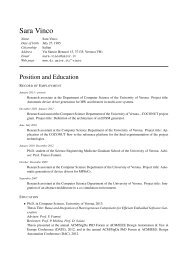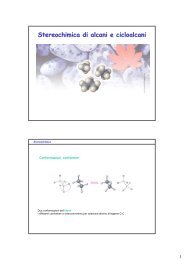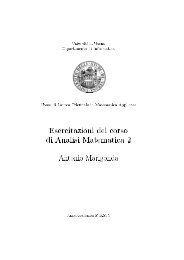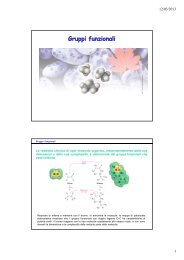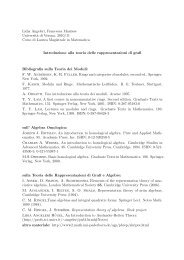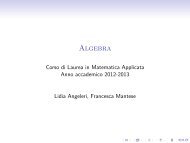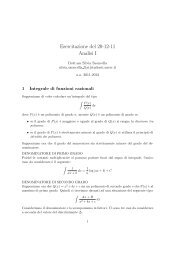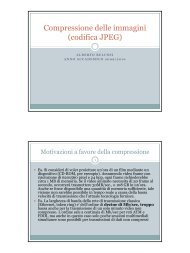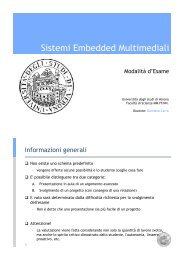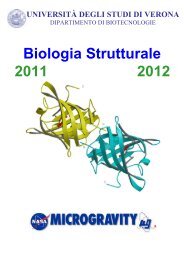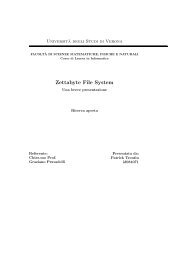Create successful ePaper yourself
Turn your PDF publications into a flip-book with our unique Google optimized e-Paper software.
e d’altra parte:<br />
19. INTEGRALI CURVILINEI, TEOREMA DI STOKES, FORMULE DI GAUSS-GREEN - CONTINUAZIONE 89<br />
∂A1<br />
∂y<br />
z sin x 2z cos x<br />
= −z − −<br />
2 x x2 2z sin x<br />
+<br />
x3 ∂A1 y sin x 2y cos x<br />
= −1 − −<br />
∂z 2 x x2 2y sin x<br />
+<br />
x3 <br />
∂A2 d cos x d<br />
= z + z 1 −<br />
∂x dx x dx<br />
1<br />
x2 <br />
z sin x z cos x<br />
sin x = − −<br />
x x2 2z sin<br />
+<br />
x3 +<br />
<br />
1 − 1<br />
x2 <br />
z cos x<br />
z sin x 2z cos x<br />
= − −<br />
x x2 2z sin<br />
+<br />
x3 + z cos x<br />
∂A2 cos x<br />
= −1 +<br />
∂z 2 x +<br />
<br />
1 − 1<br />
x2 <br />
sin x<br />
∂A3 1 d cos x d sin x 1 y sin x y cos x<br />
= + y − y = − −<br />
∂x 2 dx x dx x2 2 x x2 y cos x<br />
−<br />
x2 2y sin x<br />
+<br />
x3 = 1 y sin x 2y cos x<br />
− −<br />
2 x x2 2y sin x<br />
+<br />
x3 ∂A3 1 cos x sin x<br />
= + −<br />
∂y 2 x x2 Si ha dunque:<br />
∂A3 ∂A2<br />
−<br />
∂y ∂z =<br />
<br />
1 cos x sin x<br />
+ −<br />
2 x x2 <br />
− − 1 cos x<br />
+<br />
2 x +<br />
<br />
1 − 1<br />
x2 <br />
sin x = 1 − sin x<br />
∂A1 ∂A3<br />
−<br />
∂z ∂x =<br />
<br />
− 1 y sin x 2y cos x<br />
− −<br />
2 x x2 2y sin x<br />
+<br />
x3 <br />
1 y sin x 2y cos x<br />
− − −<br />
2 x x2 2y sin x<br />
+<br />
x3 <br />
= −1<br />
∂A2 ∂A1<br />
−<br />
∂x ∂y =<br />
<br />
z sin x 2z cos x<br />
− −<br />
x x2 2z sin<br />
+<br />
x3 <br />
z sin x 2z cos x<br />
+ z cos x − − −<br />
x x2 2z sin x<br />
+<br />
x3 <br />
= z cos x<br />
Quindi rotA(x, y, z) = (1 − sin x, −1, z cos x) = B(x, y, z) e la soluzione è stata verificata essere corretta.<br />
Esercizio 19.3. Siano dati i seguenti sottinsiemi di R 3 :<br />
S = {x 2 + y 2 + z 2 = 1, z > 0}<br />
D = {x 2 + y 2 ≤ 1, z = 0}<br />
γ = {x 2 + y 2 = 1, z = 0}<br />
e sia<br />
<br />
y<br />
F (x, y, z) =<br />
1 + z2 , x5z <strong>10</strong>0 − y, z + x 2<br />
<br />
(1) si usi il teorema della divergenza per calcolare:<br />
<br />
I := F · ˆn dσ<br />
dove ˆn è la normale esterna alla superfice chiusa Σ = S ∪ D;<br />
(2) Detta ω1 F la 1-forma differenziale canonicamente associata a F , si calcoli<br />
<br />
S<br />
γ +<br />
ω 1 F<br />
dove γ + è la curva γ orientata in senso antiorario nel piano z = 0;<br />
(3) si verifichi il teorema di Stokes per il campo F sulla superficie S.<br />
Svolgimento.<br />
Indichiamo con C = {(x, y, z) ∈ R3 : x2 + y2 + z2 ≤ 1, z ≥ 0} il volume delim<strong>it</strong>ato da Σ, denoteremo poi<br />
F = (F1, F2, F3).<br />
(1) Per il teorema della divergenza si ha:<br />
<br />
<br />
<br />
<br />
F · ˆn dσ = F · ˆn dσ + F · ˆn dσ = divF dxdydz<br />
Si ha poi<br />
Σ<br />
S<br />
D<br />
divF (x, y, z) = 0.<br />
C



